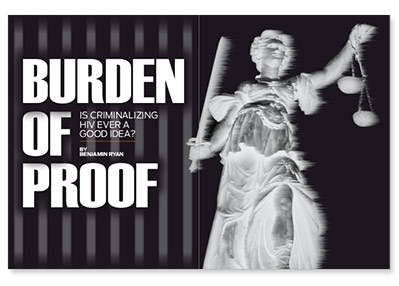
Take the HIV criminalization case of Thomas Guerra, a 29-year-old HIV-positive landscape architect in San Diego. Headlines about the case first broke in August 2014, and Guerra is slated for a January trial. The case was borne out of complaints filed by an ex-boyfriend, “Bill,” a 34-year-old working in the biotech sector who spoke with POZ under the condition that he be identified by a pseudonym.
According to Bill, he and Guerra had sex without condoms on a few occasions shortly after meeting, with Bill agreeing to do so because, as he alleges, Guerra told him he was HIV negative. Bill says that after those incidents Guerra got an HIV test, which came back positive. Bill subsequently got the news that he had contracted the virus as well.
Bill alleges he discovered text messages and emails suggesting that Guerra had known he was HIV positive for years. Additional claims, which have been spread widely in the media, allege even more deception.
Guerra’s attorney, Jim Fitzpatrick, declined to comment for this article.
Guerra is only being tried on one count of willfully exposing an infectious disease to another person, a misdemeanor with a maximum penalty of six months in prison and a $1,000 fine. (A judge also ordered him off dating websites and apps.)
The San Diego County District Attorney, who would handle a felony charge of intentionally infecting someone with HIV, has twice reviewed Guerra’s case and twice returned it to the City Attorney’s office, which handles misdemeanors.
Stressing that the San Diego County DA’s office does not discuss the details of this review process or its reasons for declining to file charges in a case, spokesperson Steve Walker remarks in an email, “We can only file criminal charges when we believe we can prove them beyond a reasonable doubt.”
Compared with other states, which may penalize mere exposure to HIV or even lack of HIV-status disclosure during sex, regardless of any risk-reduction methods undertaken, California has a particularly narrow HIV-specific statute: The single felony charge applies only to those who intentionally infect others with the virus. This places a heavy burden of proof on prosecutors.
Whatever the truth behind the DA’s decision, and whatever Guerra’s side of the story may be, his legal troubles raise larger questions about the judiciary’s place in the fight against HIV.
Some activists who seek reform of laws criminalizing HIV exposure and transmission argue that the legal system should only be involved in cases of malicious intent to harm. Additionally, many activists are chagrined that the media’s attention to such made-for-TV cases plays an outsize role in affecting public perception of the HIV epidemic. Further, activists claim that these cases are harmful to public health efforts.
People always want to talk about intentional transmission cases, but in reality they’re incredibly rare,” stresses Alison Symington, co-director of research and advocacy at the Canadian HIV/AIDS Legal Network, repeating a refrain that’s common among activists in her field.
“They become almost like urban legends, more so than something that actually happens. Studies show that most people living with HIV disclose their status to sexual partners. And most people living with HIV take steps to prevent transmission,” she says.
Indeed, researchers estimate that about half of all new HIV cases transmit from people who are unaware they have the virus. But this isn’t the message average people likely absorb when grim, monster-in-our-midst reports on the local news are their primary source of information about HIV.
The false public perception that the disease is largely spread with malicious intent rather than ignorance is exacerbated by news reports that often erroneously label such criminal cases as intent-to-infect prosecutions, when the actual accusations may be far more benign.
The HIV bogeyman mythology owes much to Randy Shilts, whose gripping 1987 history of the nascent AIDS epidemic, And the Band Played On, features a storyline of an HIV-positive French-Canadian flight attendant named Gaëtan Dugas. Dugas’s tale was pulled from the pages of a 1982 report by the U.S. Centers for Disease Control and Prevention (CDC) about the so-called “Patient Zero,” whom researchers connected to 40 out of the initial 248 U.S. AIDS cases among gay men.
Shilts’s bestselling book, which was turned into a star-studded HBO film, suggests that the peripatetically promiscuous Dugas was cavalier, even callous, in his attitude toward infecting others as he maintained his fast-paced sex life after being diagnosed with AIDS.
Some have argued that Shilts embellished the Dugas character’s nefariousness. Although Dugas’s own physician, as well as public health officials he encountered, have reported that they entreated him in vain to practice safer sex.
What is clearer is that the mythologizing of Dugas in the media—and the fact that the press paid any attention to the book, which is primarily a critique of the Reagan administration—was the result of a marketing ploy Shilts signed off on, albeit reluctantly.
Shilts’s editor, Michael Denneny, concerned that the press seemed likely to ignore the new book, says he “dragged [Shilts] along kicking and screaming” in a plot to tempt the New York Post with the Dugas element. The salacious tabloid took the bait and published a front-page headline that screamed (incorrectly) that Dugas was “THE MAN WHO GAVE US AIDS.” Subsequent journalists ran with the exaggeration, further sensationalizing Dugas and his life.
According to Phil Tiemeyer, PhD, an associate professor of history at Philadelphia University, whose 2013 book, Plane Queer: Labor, Sexuality, and AIDS in the History of Male Flight Attendants, addresses the publicity plot, Shilts and Denneny “gave mainstream America what they seemingly wanted: a narrative that finessed and embellished upon the truth to concoct a malicious AIDS villain who stills haunts us over 25 years later.”
The wave of AIDS hysteria that dominated the first decade of the epidemic led to a rash of HIV-specific U.S. criminal statutes in the late 1980s and early 1990s. Today, 33 states have such laws. And yet there is no data to support the claim that these laws actually protect the public from HIV. Instead, activists argue, the statutes have deleterious effects: They discourage testing, disclosure to partners, and cooperation between people with HIV and public health officials; and they ultimately drive new infections.
In the words of a March 2014 statement in which the U.S. Department of Justice (DOJ) called for reforms to these statutes, “Most of these laws do not account for actual scientifically supported level of risk by type of activities engaged in or risk reduction measures undertaken.
“As a result, many of these state laws criminalize behaviors that the [CDC] regards as posing either no or negligible risk for HIV transmission even in the absence of risk reduction measures.”
The DOJ has recommended that states abolish HIV-specific penal codes except in the cases of people who intend to infect others (whether or not they actually succeed), and that states allow HIV status to be used as a consideration for the criminal liability of a defendant accused of a sex crime such as rape.
“Part of the reason the DOJ set the bar this high—I don’t think it’s ridiculously high, I think it’s appropriately high—is because many other people who do not warrant prosecution unfortunately end up being prosecuted under laws that don’t reflect updated scientific knowledge about HIV,” says Edwin Bernard, coordinator of the HIV Justice Network in Brighton, England.
Many HIV activist legal groups, such as the HIV Justice Network or the Sero Project in the United States, go further than the DOJ, however, arguing that there should be no HIV-specific penal codes whatsoever.
Existing statutes should suffice for the rare intent-to-harm cases, these groups maintain, including those covering assault and bodily harm. Furthermore, they say, targeting a single infectious disease with its own set of laws is unscientific as well as stigmatizing for those who are living with the virus.
So if the legal bar for prosecuting HIV transmission in California in particular is appropriately high—although the language of the law does single out HIV—where does Thomas Guerra’s case fit into the equation?
With the San Diego prosecutor declining to bring intent-to-infect felony charges against him, does that mean he should not be prosecuted at all? And what role, if any, should the state play in dealing with such an individual?
Prosecutors face several high hurdles when attempting to convict someone for intentionally transmitting HIV. They must prove beyond a reasonable doubt that the defendant knew he or she had HIV, was aware of how the virus is transmitted and how to protect others, did not take such precautions, intended to infect someone else, engaged in behavior that could logically lead to infection, and actually did infect the person he or she intended to infect. (Of the very few successful intent-to-infect prosecutions, a number have actually involved people injecting others with HIV.)
It is particularly challenging to prove that the defendant was the source of the complainant’s infection. A genetic test finding that the viruses two people carry are nearly identical strains does not actually prove who infected the other—although a lack of genetic similarity between strains can exonerate a defendant. The matter is further complicated when each person has had multiple sex partners, particularly if they overlap and the other partners have genetically similar viruses, or if needle-sharing is an additional risk factor.
As is typical in criminal law, prosecutors in an HIV transmission or exposure case will often attempt to corner a defendant into a plea bargain.
“They wave this really terrible law at them and they basically get people to plead guilty to a lesser law that is sort of the equivalent of reckless endangerment or grievous bodily harm,” says Bernard.
In the case of a defendant who is recklessly, but unintentionally, infecting others, many activists argue that the public health system rather than the legal apparatus is the best tool society has to help stop the spread of the virus.
“The advantage to using public health is it’s individualized,” says Alison Symington. “And it’s flexible. Public health has the ability to meet someone where they’re at and figure out what do they need. Do they need support, do they need counseling, do they need some kind of directive order? The criminal justice system doesn’t have that kind of flexibility.”
In a recent case in Washington state, the Seattle and King County Public Health Department ordered an HIV-positive man to enter into medical care and attend counseling sessions after he allegedly infected eight people with the virus. According to department spokesperson Hilary Karasz, this move was a “legal enforcement of a public health action” as opposed to a prosecution.
Karasz says the man is now receiving HIV treatment. (Recent research suggests that antiretroviral treatment can make someone with HIV virtually uninfectious.) But if he does not comply with the order in the future, the county court could find him in contempt, leading to fines or possibly incarceration.
Activists applaud public health interventions in such cases, if not actual legal threats to back them up. But if a gentler guiding hand fails to help an individual refrain from behavior that poses a major threat to the public, many activists are still uncomfortable with the suggestion that any kind of legal iron fist is warranted.
When asked about how to proceed after a failed public health intervention, Scott Schoettes, HIV project director at Lambda Legal, says, “I guess I’m not going to move off of our position of there needing to be an intent-to-harm or an intent-to-transmit” threshold for legal action. “It does concern me when we start talking about court-mandated treatment. Because that’s a very slippery slope.
“Everybody’s definition of ‘reckless’ is going to be different,” Schoettes continues. “There are lots of people out there [who think] that if you’re HIV positive and you have sex, that’s reckless. And then if you’re having a lot of sex, or sex with multiple partners, people think that’s crazy. And so we have to avoid letting it get to that place of letting people’s fears and their desire to push any type of responsibility onto the other party—we can’t let that decide what the law is.”
The police powers that the U.S. Constitution grants individual states also oblige them to protect the health and welfare of their people. Out of this obligation grew the nation’s public health apparatus, which we have recently seen in all its idiosyncratic and dysfunctional glory as states have responded to the Ebola outbreak in a highly politicized and patchwork manner.
The debate over quarantining health care workers returning to the United States after treating Ebola patients in West Africa exemplifies the balancing act a state must play as it seeks to protect the public from disease while honoring the personal liberties and due process the Constitution guarantees individual Americans.
When it comes to the government’s responsibility to fight HIV, the state’s role in the legal realm is complicated by the fact that most cases of transmission involve a consensual act between adults.
Sean Strub, executive director of the Sero Project and founder of POZ, says there is a “huge difference [between] protecting the public from health threats to which they can be exposed simply by going about their daily business—riding the bus, drinking water from their tap, going to work—versus the public health interest in protecting people from a risk they only might face as a result of making a decision to engage in intimate behavior with someone else.
“Every time there is coverage of these cases, it reinforces the idea that it is someone else’s responsibility to protect the negative or untested person from HIV,” Strub says, “which undercuts the most basic message about sexual health—personal responsibility—and creates an illusion of safety for those who are untested or negative.”
What the state does have a responsibility to do, Scott Schoettes underlines, is to educate citizens about how to protect themselves against HIV, as well as about how HIV is not transmitted. Furthermore, he sees a vital element missing from how defendants in these criminal cases are treated—or, more specifically, the lack of treatment they receive.
“I think that one person’s sociopath is another person’s person with massive mental health issues,” Schoettes says.
Bill, Thomas Guerra’s ex, is actually on the same page as Schoettes, seeing a tragic lack of mental health support in the United States, notably in the cases of people caught up in the criminal justice process.
Bill admits that the legal system is unlikely to provide effective help for people with mental illness. And regardless of the outcome of the Guerra case, Bill acknowledges his own role in contracting HIV from his ex-boyfriend. And he recognizes that as an HIV-positive man himself, he could one day be subject to prosecution as well, which he thinks would be unjust.
“I have been positive for over a year now,” Bill says. “I don’t always use condoms. I’ve been on medication the entire time. I’ve been undetectable since two months after I became infected. None of my sex partners that I’ve had unprotected sex with who are negative have become positive. If somebody accused me, I would have a hard time understanding how, after thoroughly discussing the risks before, there would be grounds for them to not take responsibility for their part.”





4 Comments
4 Comments